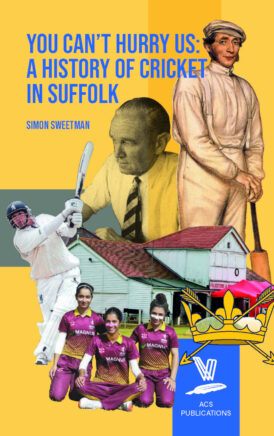You Can’t Hurry Us: A History of Cricket in Suffolk
Martin Chandler |Published: 2024
Pages: 187
Author: Sweetman, Simon
Publisher: ACS
Rating: 3.5 stars

Just in case anyone else does the same thing I did, I will begin by underlining the sub-title in this one. I initially misread that as meaning not what it actually says but, presumably, what my brain expected it to say. Thus I was expecting and, I have to confess not particularly looking forward to, a history of the Suffolk County Cricket Club.
In some ways my mistake is a distinction without a difference, as the fortunes of the county club play a major part in Simon Sweetman’s narrative, but his book is much more than a wade through minutes of past committee meetings and local press reports of matches played by the county. The approach Sweetman takes is a great deal more holistic, and whilst the focus may be on cricket in Suffolk many of the challenges identified apply equally to other counties.
Suffolk itself is as far to the East as anywhere in England gets. It is one of the larger counties, in terms of area, but not so much in terms of population, county town Ipswich being by some distance the largest urban centre. It is bordered by Norfolk to the north, Essex to the south, Cambridgeshire to the west and the North Sea to the east.
Cricket in Suffolk has a long history, going back as far as 1743, but there was no county club until 1902. That incarnation of the club made steady progress, but was not revived after the Great War and county cricket in Suffolk was then put on hold until 1932. The following year saw Bob Durham become the club scorer a role, along with editing the county yearbook, that he fulfilled for the next forty years and the material Sweetman had available to him, as he gratefully acknowledges, would have been much poorer without Durham’s efforts.
There are, naturally, reports of cricket matches and analyses of seasons past, but the club game in Suffolk is not overlooked, and the story of how league cricket took over is told. Brief biographical sketches of the counties more important players appear at regular intervals through the narrative and help to paint the picture of the development of the county club. Few are household names but the first of them most certainly is, that giant of cricketing pre-history Fuller Pilch, and in the 1990s the much loved Derek Randall appeared, and played for Suffolk for seven summers.
Some books about cricket history can be criticised simply on the basis that they take the title of their genre too literally, and the narrative tails off as the present day approaches and there is no attempt to look forward. That certainly isn’t an accusation that can be levelled at Sweetman who takes a hard look at these important questions. The women’s game and age group cricket seem to be well set up, as indeed does the men’s recreational game, but like all of us Sweetman clearly has reservations about the future. One of the pieces of information that leapt out at me from the book is that in 1970 there were reckoned to be as many as 154 cricket clubs in Suffolk. It is not a stat that is revisited and perhaps is simply not readily available, but how many would there be now? If it were even half that number I would be pleasantly surprised.
Books about the game in what are now known as the National Counties, but which I suspect will always in my mind be the Minor Counties, are not uncommon, but are of uneven quality and have a variety of approaches to their subject matter. For my part I would certainly like to see more written about them, and Sweetman’s manner of going about the task strikes me as one which other researchers and writers could usefully utilise for their own work.
If cricket in Suffolk as a subject is one that appeals, then You Can’t Hurry Us: A History of Cricket in Suffolk is highly recommended.






Where can I buy a copy of this book please?
Comment by Yvonne Minto | 11:10am GMT 20 November 2024
https://acscricket.com/
Comment by Martin Chandler | 7:39am GMT 21 November 2024